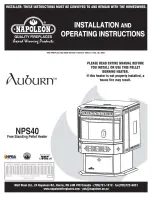
Page 10
Installation and operation manual - Atlas woodburning cookstove
ENGLISH
3. Fuel
3.1 Recommended Fuel
Wood burner performance depends greatly on the fuel used. Good firewood has been cut to
the correct length for the appliance, split to a range of sizes and stacked in the open until its
moisture content is down to 15% to 20%. Proper fuel makes it easier to regulate heat and keep
the wood burner and flue in better condition.
Use split pieces of wood, they will burn better than logs. Make sure to have various size of
wood.Thin firewood should be used to get higher thermal power, use it after lighting the fire for
a faster response as more heat is needed. Use thick wood for a slower combustion when less
heat is needed or for overnight fire. If necessary, when starting the fire, burn a combination of
thin and thick firewood.
Store firewood in a dry, ventilated place protected from the rain for one to two years depending
on the storage and weather conditions.
DO NOT BURN GARBAGE OF ANY KIND, COAL OR CHARCOAL, TREATED, PAINTED OR
COATED WOOD, PLYWOOD OR PARTICLE BOARD, FINE PAPER, COLORED PAPER OR
CARDBOARD, SALT WATER DRIFTWOOD, MANUFACTURED LOGS CONTAINING WAX OR
CHEMICAL ADDITIVES, RAILROAD TIES AND LIQUIDS SUCH AS KEROSENE OR DIESEL
FUEL TO START A FIRE.
Do not burn manufactured logs made of wax impregnated sawdust or
logs with any chemical additives. Manufactured logs made of 100%
compressed sawdust can be burned with caution in the number of these
logs burned at one time. Start with one manufactured log and see how
the cookstove reacts. Never use more than two manufactured logs.
4. Stove Operation
4.1 Components Location
A
Oven thermometer
B
Combustion chamber
C
Air control
D
Accessory compartment
E
Cleaning access panel
F
Oven
G
Cooking grills
H
Ash pan
A
E
F
B
C
D
G
H
Figure 4: Component Location











































